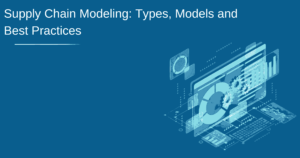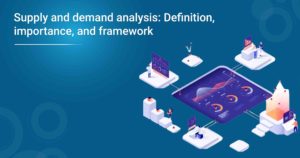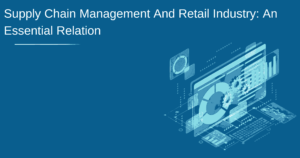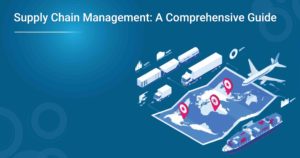Supply and demand analysis is an essential tool for businesses of all sizes. It enables them to better understand the market forces that drive their industry, allowing them to make data-driven decisions that can help them maximise profits and minimise losses. But what exactly is supply and demand analysis? In this blog post, we’ll explore the definition of this important concept, its importance in today’s business landscape, and a framework to apply it effectively. Read on to learn more!
Check out our Advanced Executive Certificate in Supply Chain Strategy and Operations Management to learn detailed supply and demand analysis.
What is Supply and Demand Analysis?
Supply and demand analysis studies how prices change in response to the availability of goods and services. It is a key tool used by economists to understand the behaviour of businesses and consumers.
The basic idea behind supply and demand analysis is that prices are determined by the interaction between buyers and sellers in the marketplace. The amount of a good or service buyers can buy at a given price is known as demand. The number of goods or services sellers can supply at a given price is known as supply.
Changes in either supply or demand can lead to changes in prices. An increase in supply, all else being equal, will lead to lower prices. Demand increases, all else being equal, will lead to higher prices. A decrease in either demand or supply will have the opposite effect on prices.
Supply and demand analysis is often used to help explain economic phenomena such as inflation, unemployment, and economic growth. It can also be used to predict how changes in economic conditions might impact prices.
How Does Supply And Demand Analysis Work?
Supply and demand analysis is a powerful tool to help you understand how your business works. By analysing the factors that affect supply and demand, you can make informed decisions about pricing, production, and other essential aspects of your business.
To perform a supply and demand analysis, you need to understand the basic concepts of supply and demand. The supply and demand law is a fundamental economic principle that explains the interaction between buyers and sellers in the marketplace. The law of supply and demand is supported by the following four principles:
- There is a relationship between price and quantity.
- The connection decides the price of goods or services between supply and demand in the market.
- The market equilibrium occurs when the quantity demanded equals the quantity supplied.
- Changes in market conditions can cause shifts in the equilibrium price and quantity.
Supply is the number of goods or services available for sale at a given price. Demand refers to the number of goods or services consumers purchase at a given price. The law of supply and demand states that when there is more demand for a good or service than there is supply, the price of the good or service will increase. Conversely, the price will decrease when there is more supply than demand.
What is The Importance of Supply and Demand Analysis?
Supply and demand analysis is a basic economic tool used to understand the market’s relationship between buyers and sellers. It can be used to determine the prices of goods and services in a market and understand the forces influencing them.
Demand analysis looks at how much of a good or service people are willing to buy at different prices. This information can be used to understand consumer behaviour and make decisions about pricing and production.
Supply analysis looks at how much of a good or service producers can supply at different prices. This information can be used to understand business behaviour and make decisions about pricing and production.
The interaction between supply and demand decides the price of goods and services in a market. If there is more demand than supply, the price will increase. If there is more supply than demand, the price will decrease.
The importance of supply and demand analysis lies in its ability to help decision-makers understand market conditions and make informed decisions about pricing, production, and other factors that influence market performance.
Benefits of Supply And Demand Analysis
- Improved Pricing: Supply and demand analysis can be used to set accurate prices for goods and services, helping businesses maximise profits while ensuring customers get a good deal.
- Better Forecasting: With the help of supply and demand analysis, businesses can predict future trends in their market with great accuracy, allowing companies to plan efficiently so as not to miss out on opportunities or fall behind competitors.
- Maximizing Profits: By understanding the relationship between supply and demand, businesses are better equipped to adjust their operations accordingly to take full advantage of economic conditions – both short-term spikes and long-term changes – which may result in increased profits.
- Increased Efficiency: Through analysing supply and demand dynamics, businesses can identify areas where they may need fewer resources (people/money) than currently allocated, leading them to become more efficient with their use of capital. This also allows firms to reduce costs without harming sales or customer satisfaction levels.
- Reduced Risk: Companies that accurately forecast future trends are far less likely to suffer from sudden drops in sales due to unexpected changes in the marketplace, enabling them to make necessary adjustments before problems arise rather than after it’s too late!
- Enhanced Customer Service Levels: When business owners understand how pricing affects consumers’ buying decisions, they can make more informed decisions about what items should be discounted at certain times throughout the year, allowing them to provide maximum value for money at all times whilst still delivering an excellent level of service overall!
How Can Supply and Demand Analysis Help the Economy?
Supply and demand analysis is a powerful tool for understanding the behaviour of markets, prices, and economies. It allows us to analyze how changes in the supply or demand of goods and services affect the economy. Supply and demand analysis can help governments set sensible policies by allowing them to understand better how different factors might affect market conditions in their countries.
For example, they can use this knowledge to determine what taxes should be imposed on goods or services that are in high demand or scarce supply to encourage more efficient production while still providing consumers with an adequate amount of goods at reasonable prices.
Furthermore, businesses also benefit from using supply and demand analysis when deciding on pricing strategies.
They assess whether increasing prices will lead customers away from buying their products due to increased cost; if so, then adjusting price levels may be necessary for sales growth over time. In addition, companies examine elasticity – which measures how responsive people are to changes in price – before choosing marketing strategies that work best for their target audiences.
Overall, supply and demand analysis is essential because it helps both governments and businesses create effective economic policies that promote long-term stability through the balanced distribution of resources across society’s needs.
Read More: What is Supply Chain Finance? A Detailed Analysis
Supply And Demand Analysis Framework
The supply and demand analysis framework is a commonly used tool for analysing economic trends, market conditions, and consumer behaviour. This framework provides an empirical perspective on understanding the dynamics of markets and how buyers and sellers shape them. The basic premise of supply and demand analysis is the interaction between buyers and sellers determines the price and quantity in any given market.
To understand these interactions, it is necessary to consider factors such as production costs, changes in consumer preferences or tastes, availability of substitutes or complementary goods/services, government policies related to pricing or trade barriers etc.
At its core, supply-demand analysis uses two curves: one representing the quantity demanded (demand curve) versus price; another representing the cost associated with producing each additional unit (supply curve).
Together these curves allow us to identify equilibrium points where both sides have reached their respective goals – i.e., where producers have maximized profit by meeting consumer needs at acceptable prices. By studying shifts along either curve due to changes in underlying variables, we can better understand why certain markets behave in certain ways under different circumstances.
Finally, this approach also allows us to make predictions about future outcomes based on current data points – allowing firms/governments alike to develop plans for long-term growth or mitigation strategies based on expectations about the future states of different markets within their specific context.
How Does Supply And Demand Analysis Framework Work?

The Supply and Demand Analysis framework uses the principles of economics to explain how buyers and sellers interact in a market. The basic concept is that prices will either increase or decrease accordingly when there is an imbalance in demand for a product or service.
1) Supply: This refers to how much of a good or service suppliers are willing and able to produce at different prices. It depends on factors such as technology, cost of inputs, taxes, subsidies etc.
2) Demand: This refers to how many people want (or ‘demand’) a certain good or service at different prices. It depends on income levels, tastes/preferences, price expectations etc.
3) Equilibrium Price & Quantity: These are the balance points where supply equals demand – i.e., quantity supplied by producers matches what consumers can acquire at that given price level. When this equilibrium is disturbed through an event such as increased production costs or higher consumer incomes, new equilibriums need to be established, leading to adjustments in both price & quantity demanded/supplied until the balance is restored.
4) Elasticity Of Supply And Demand: This measures the sensitivity of changes in demand and supply due to external factors like taxes & subsidies, which affects the pricing decisions of both buyers & sellers. Generally, if one increases while the other decreases, it causes a larger change than vice versa resulting in changes in equilibrium quantities & prices over some time.
Different Methods of Demand and Supply Analysis1
- Identify the Market: The first step in supply and demand analysis is to identify the market of interest. This could include tracking a particular product or industry, studying a specific geographic region where goods are traded, or monitoring an entire economic sector.
- Gather Data: Once the market has been identified, data needs to be gathered about both supply and demand for that good or service within that market. This data can come from various sources, including government reports, trade publications, company earnings reports and surveys of consumers’ buying habits.
- Analyze Supply: Supply analysis involves looking at production costs such as labour inputs and raw material prices as well as other factors such as transportation costs which affect how much a producer can make on any given item before losing money on it. By understanding these cost structure elements, one can better predict how producers will respond to price-level changes over time by either increasing or decreasing their production level accordingly.
- Evaluate Demand: On the demand side, numerous factors must be considered when conducting an analysis, including consumer preferences and income levels, along with political stability in countries where goods may be sold abroad, among others, if applicable.
- Compare Supply & Demand Factors: Using all of this collected information, it should then become possible for analysts to compare various supply-side characteristics with those found on the demand side. So predictions regarding future price movements can begin based on trends found throughout each respective factor associated with them.
- Monitor Results & Adjustments: Finally, once initial forecasts have been put together, it is important for analysts not just stop there but rather continue tracking results ongoing so any adjustments needed going forward can be quickly applied if necessary to keep projections updated accurately over time.
Latest Trends in Supply and Demand Analysis

- Big Data Analytics: With the help of big data analytics, companies can now understand supply and demand patterns in real time, enabling them to adjust their strategies accordingly quickly. This gives them a competitive advantage over those still relying on traditional methods.
- Predictive Modeling: Predictive modelling is used to identify future trends in supply and demand by analysing past behaviours and current market conditions. Companies use this technique to make more informed decisions about how much product they need to produce or purchase and when it’s most advantageous for them to do so.
- Automated Demand Planning: Automated demand planning systems enable businesses to accurately forecast customer demands based on historical sales figures and external factors such as seasonality, weather, economic indicators etc. These systems also allow companies to simulate different scenarios to optimise production levels across multiple locations.
- Supply Chain Visibility: This trend focuses on ensuring that all participants throughout the supply chain have visibility into inventory levels at any given time, along with access to key performance metrics like delivery times or cost per unit shipped etc.
- Agile Inventory Management: The concept behind agile inventory management is that instead of having large amounts of stock sitting idle waiting for orders, inventory is better managed through just-in-time techniques, which involve replenishing small stocks at regular intervals. This helps businesses reduce storage, transportation and waste costs while ensuring there’s always enough stock available to meet customers’ needs without overstocking.
What The Future Awaits For Supply and Demand Analysis?
The future of supply and demand analysis lies in leveraging advanced technologies to make decisions that lead to a more efficient and profitable market. As the world becomes increasingly connected, data collection will become easier and more accurate than ever before, thus providing better insights into how customers interact with products or services. This will enable companies to anticipate customer needs better, identify new markets for their offerings, and adjust pricing strategies accordingly.
Read More: What is Supply Chain Visibility? 10 key points
In addition, artificial intelligence (AI) algorithms such as Machine Learning (ML) can help in automating many aspects of supply chain management. AI systems can monitor global market trends by gathering data from multiple sources, allowing companies to respond quickly to changes.
Furthermore, AI-based predictive analytics can provide real-time predictions about customer behaviour, allowing businesses to proactively create strategies that maximise profits while minimising losses due to unexpected shifts in market conditions.
Lastly, blockchain technology is also set to revolutionise supply chain management and help streamline processes like tracking goods through the system. Creating an immutable record of transactions linked together through cryptography makes it much harder for fraudulent activities such as counterfeiting or double spending money from the same source possible within a given networked environment.
The transparency provided by blockchain would also help reduce costs associated with manual record-keeping by cutting out intermediaries who needlessly add complexity and cost throughout the process without adding value.
Overall these advancements have created vast opportunities for businesses seeking competitive advantage over their competitors through improved efficiency of operations.
Conclusion
Overall, supply and demand analysis is a crucial tool for understanding the market dynamics of a given product. It helps to identify trends in pricing, production levels and other factors affecting the balance between buyers and sellers. By using this framework, businesses can identify ways to maximize profits while providing services or products that meet the needs of consumers. A thorough grasp of what drives supply and demand will allow businesses to make more informed decisions about their operations.
The Advanced Executive Certificate in Supply Chain Strategy and Operations Management can provide a comprehensive supply and demand analysis overview. You will learn about the different monitoring methods, analyzing, forecasting, and optimizing your supply chain to ensure maximum efficiency. Additionally, this program offers insight into how to manage risks associated with a fluctuating demand environment. With guidance from experts in the field, you will gain valuable knowledge essential for successful supply chain management.
More Information:
What Is A Supply Chain Control Tower? Types & Uses
What is Supply Chain Consulting? Meaning and Frameworks
What Is Supply Chain Management And Why Is It Important?



























